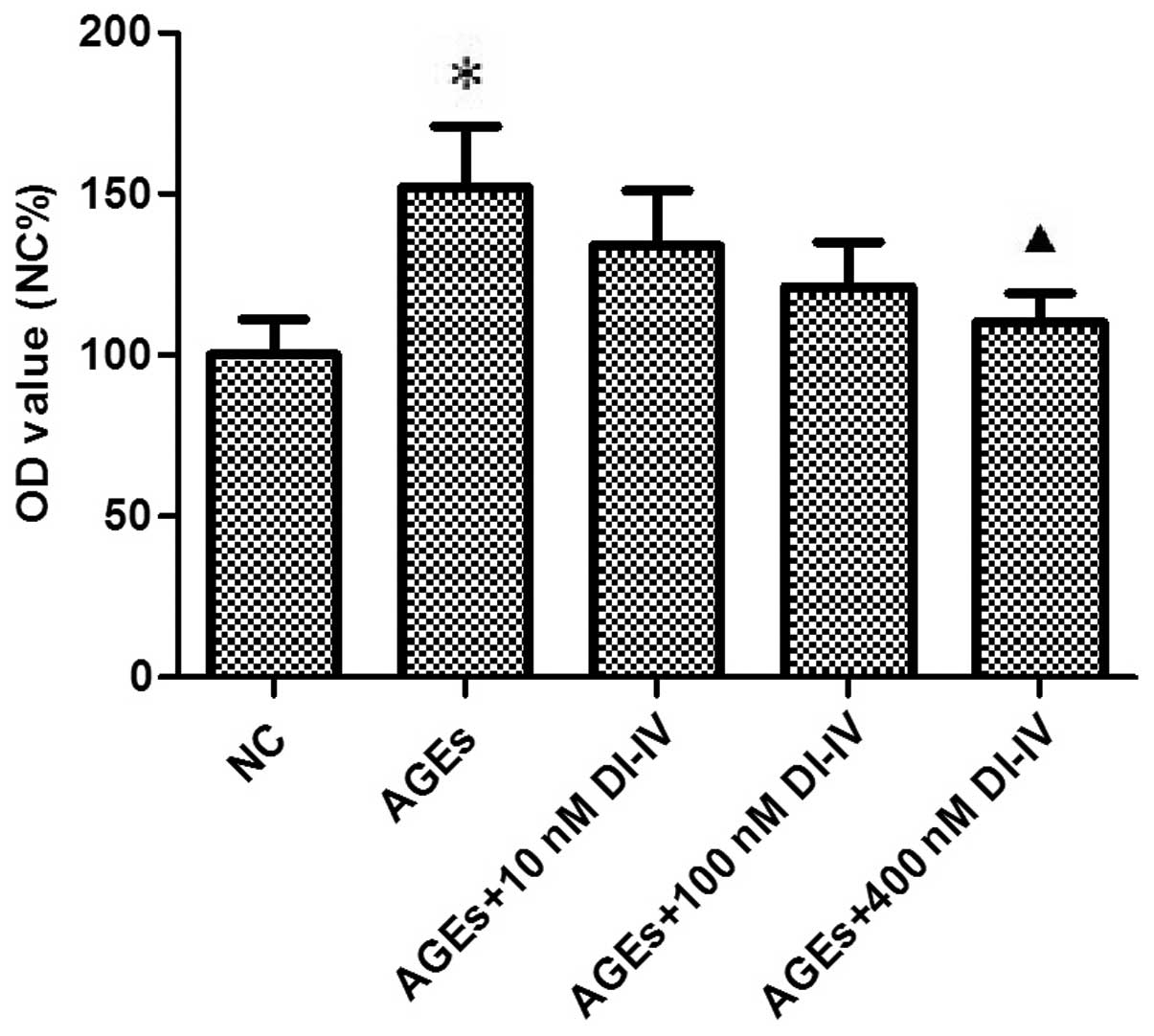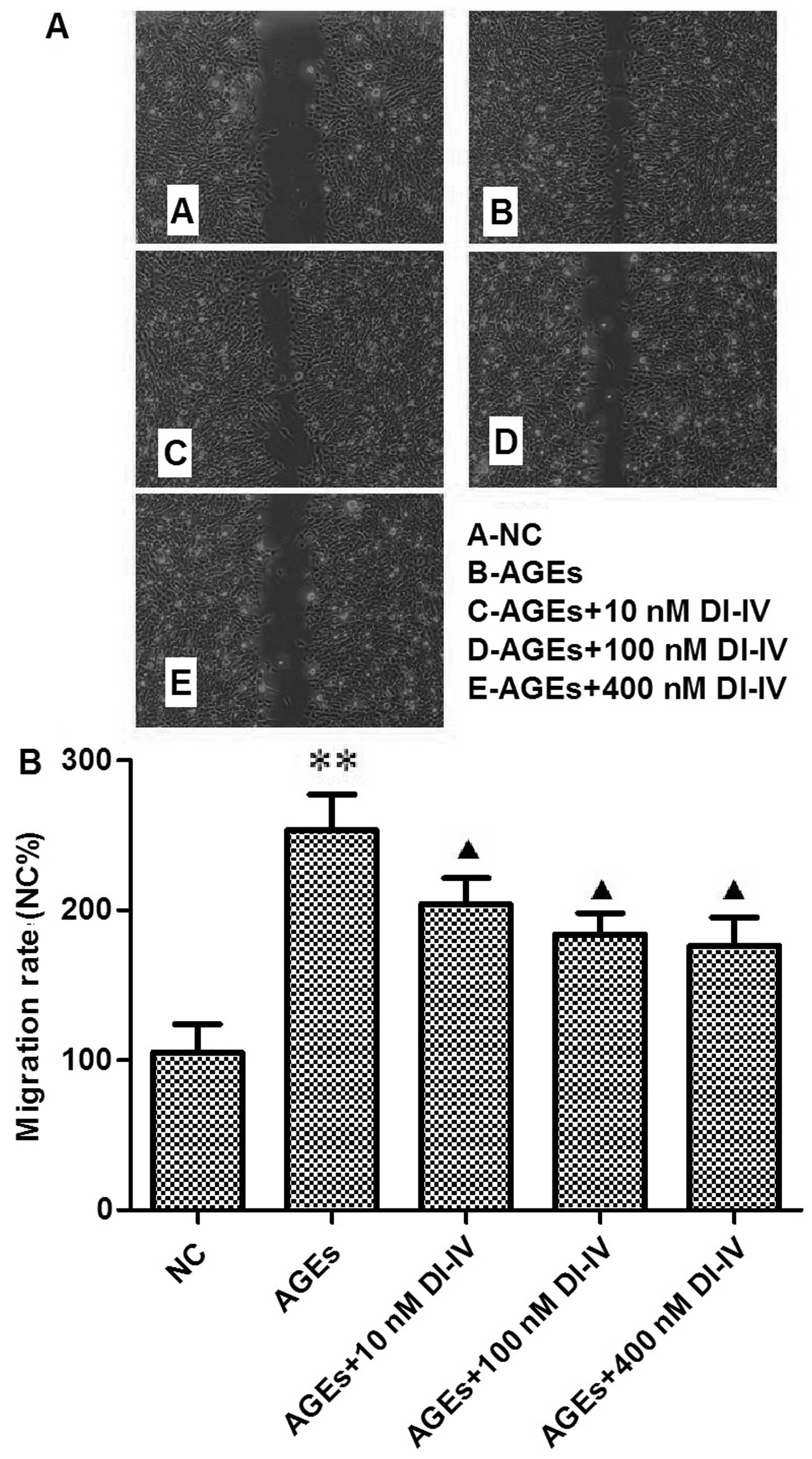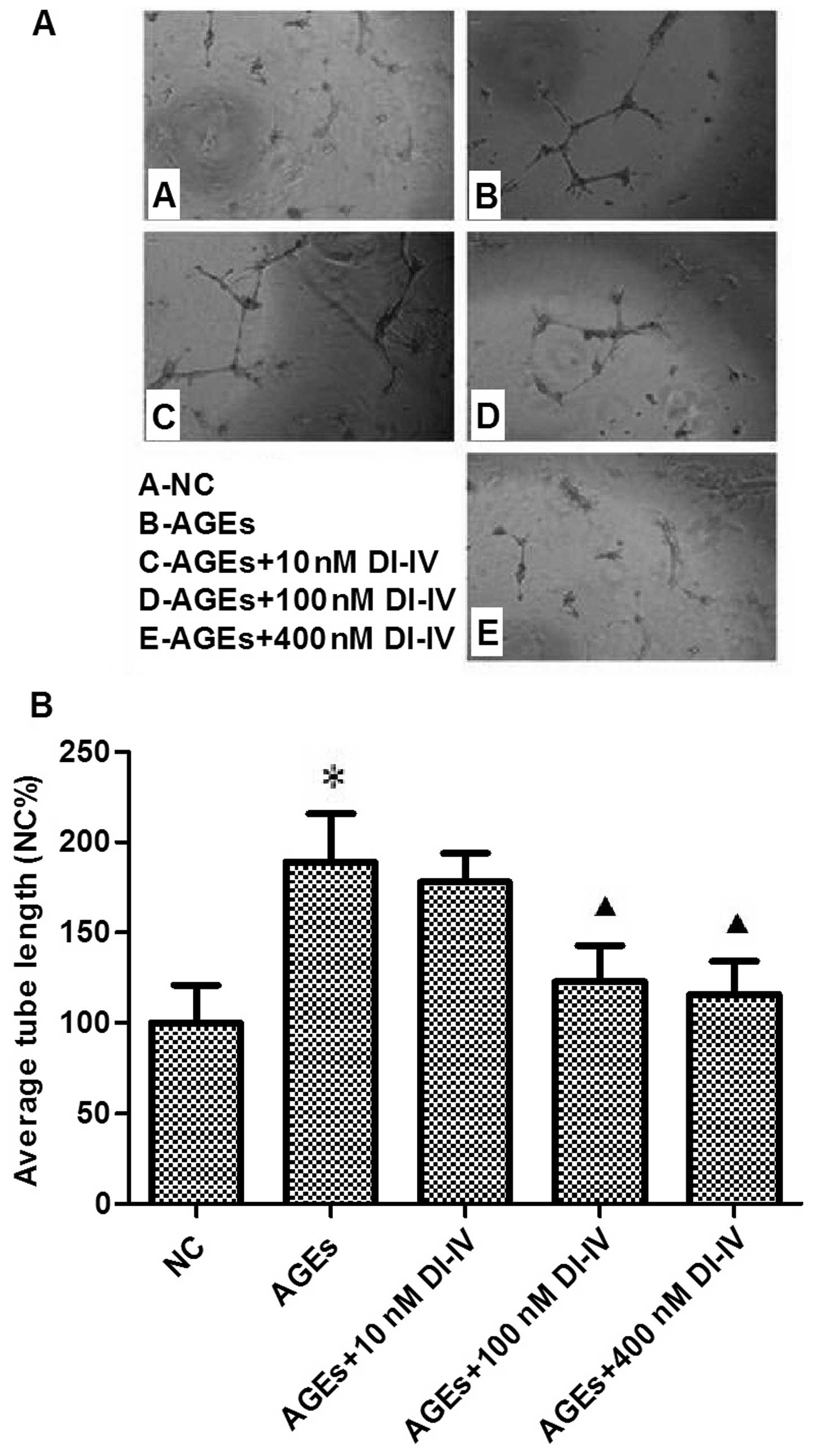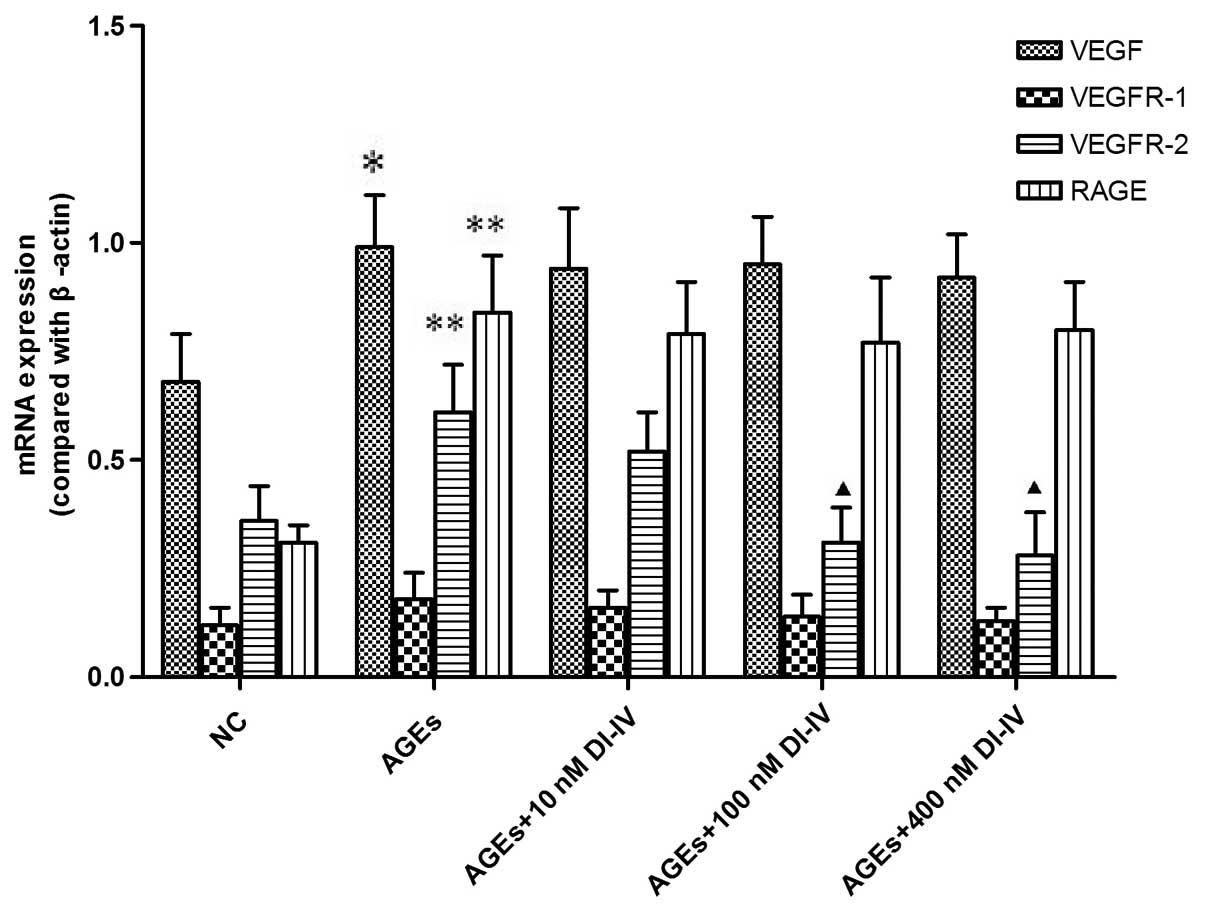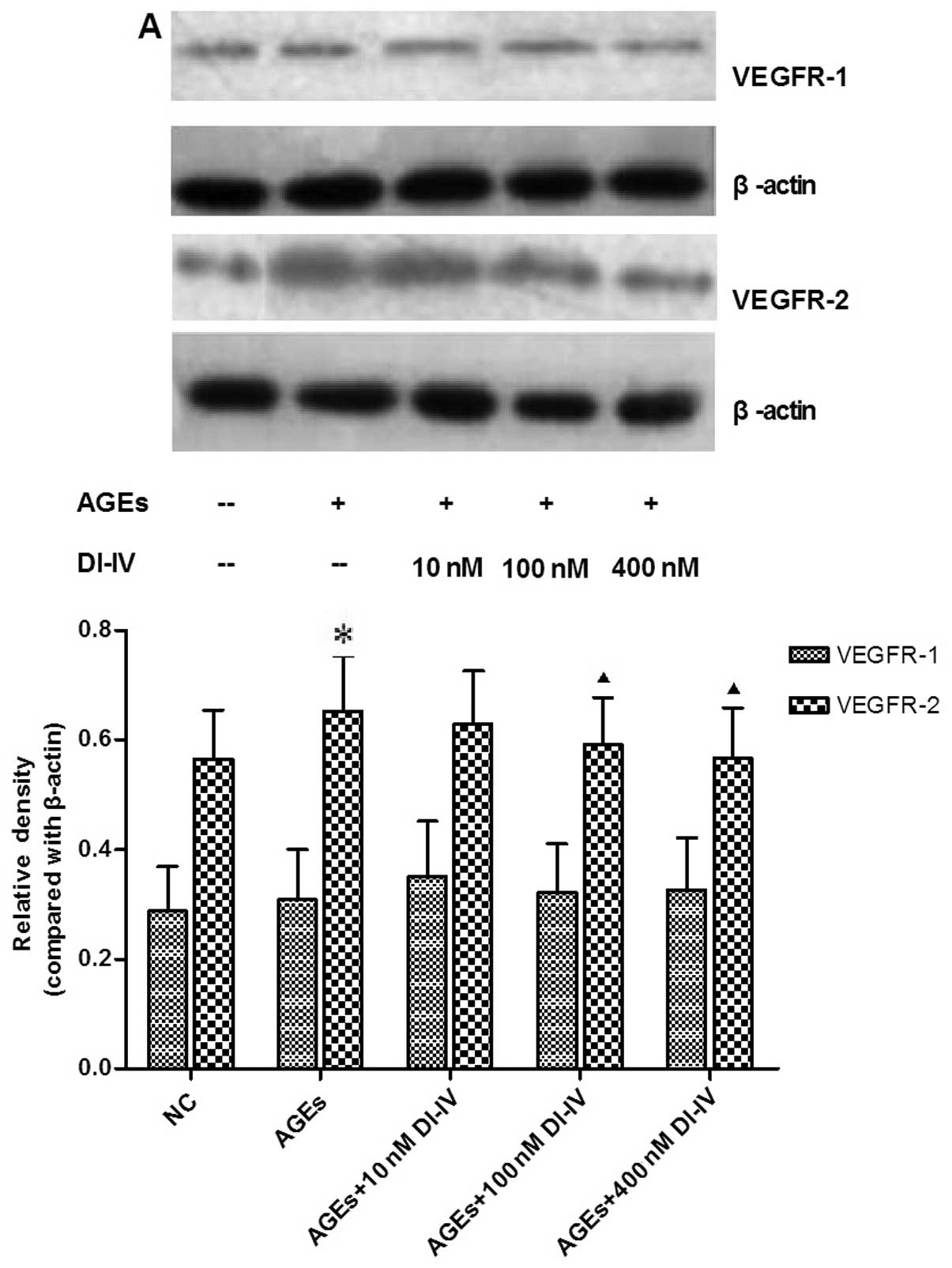Domain I-IV of β2-glycoprotein I inhibits advanced glycation end product-induced angiogenesis by down-regulating vascular endothelial growth factor 2 signaling
- Authors:
- Published online on: November 18, 2014 https://doi.org/10.3892/mmr.2014.2970
- Pages: 2167-2172
Abstract
Introduction
Diabetes mellitus is a serious chronic disease, with an increasing worldwide incidence each year. According to statistics from the World Health Organization, the number of patients with diabetes reached 346,000,000 in 2011 (1). One of the microvascular complications of diabetes, diabetic retinopathy (DR) and, in particular, proliferative diabetic retinopathy (PDR), threatens the vision of patients with diabetes and is the leading cause of blindness among working-age adults (2).
Angiogenesis is the key pathological feature of PDR (3). Advanced glycation end-products (AGEs) are proteins or lipids that are non-enzymatically glycated and oxidized following contact with aldose sugars (4). Animal experiments have revealed that foods rich in AGEs are a risk factor for angiogenesis-associated diseases (5). AGEs promote angiogenesis by increasing the expression of vascular endothelial growth factor (VEGF) in vitro and there is a positive correlation between the levels of AGE and PDR in vivo (6). These findings suggest that AGE are involved in the pathogenesis of PDR.
β2-Glycoprotein I (β2-GPI), also termed apolipoprotein H, is a phospholipid-binding plasma protein, which consists of five homologous repeated units. β2-GPI is the major autoantigen in patients with antiphospholipid syndrome (7). β2-GPI has anti-angiogenetic properties (8) and one of its mutants, in which domain V of domains I–IV is absent (DI-IV), has the potential to produce more marked effects (9).
Our previous study was the first, to the best of our knowledge, to demonstrate that while β2-GPI and DI-IV inhibited angiogenesis in human umbilical vein endothelial cells, DI-IV had a more marked effect (10). Another study found that DI-IV inhibits angiogenesis by downregulating VEGF signaling pathways (11). Therefore, DI-IV may provide a potential treatment for diabetic retinopathy.
The present study investigated whether DI-IV was able to inhibit AGE-induced angiogenesis in RF/6A rhesus macaque choroid-retinal vascular endothelial cells and examined the potential mechanisms involved.
Materials and methods
Materials and reagents
The RF/6A cell line was purchased from the China Center for Type Culture Collection (Wuhan, China). DI-IV was purchased from Tianjin LuoSai Technology Development Co., Ltd. (Tianjin, China) and was produced as previously described (12). AGE-bovine serum albumin (BSA) was purchased from Biovision (Mountain View, CA, USA). Dulbecco’s modified Eagle’s medium (DMEM) was purchased from Gibco-BRL (Grand Island, NY, USA). Fetal bovine serum (FBS) and pancreatin were purchased from Beijing Solarbio Technology, Ltd. (Beijing, China). CellTiter 96® AQueous One Solution regent and Matrigel were purchased from BD Biosciences (Bedford, MA, USA). Monoclonal antibodies to VEGF receptor (VEGFR)-1, VEGFR-2, protein kinase B (Akt), extracellular signal-regulated kinase (ERK), phosphorylated (p)-Akt and p-ERK, anti-mouse immunoglobulin (Ig)G and anti-rabbit IgG labeled with horseradish peroxidase (HRP) were all purchased from Cell Signaling Technology, Inc. (Beverly, MA, USA). All other reagents used were purchased from Sigma (St. Louis, MO, USA).
RF/6A cell culture
The RF/6A cells were cultured in high-glucose DMEM containing 10% FBS and incubated at 37°C in 5% CO2. The cells were seeded at a density of 5×104 cells/ml and divided into the following five treatment groups: 100 μg/ml BSA as a control, 100 μg/ml AGE, 100 μg/ml AGE+10 nm DI-IV, 100 μg/ml AGE+100 nm DI-IV and 100 μg/ml AGE+400 nm DI-IV.
RF/6A proliferation assay
The RF/6A cells were seeded onto 96-well tissue culture plates (100 μl/well; 5×104 cells/ml) and incubated in the regular medium and incubation conditions described above for 24 h and subsequently with serum-free medium (starved) for 12 h.
Following removal of the growth medium, the cells were incubated for an additional 72 h in medium supplemented with AGE and/or DI-IV, as described above. Subsequently, 20 μl CellTiter 96® AQueous One Solution regent, mixed with 100 μl growth medium, was added to each well and the cells were incubated at 37°C for between 1 and 4 h. The absorbance of each well at 490 nm was measured using a microplate reader (BioTek Synergy 2; BioTek, Winooski, VT, USA).
In vitro wound healing assay
The RF/6A cells were seeded onto 48-well plates, which were coated with 50 μl 0.1% gelatin. When the cells had formed a monolayer, a wound, termed the ‘denuded area’, was introduced by clearing an area of the monolayer with a micropipette tip. The culture medium in the well was carefully removed and the cells were washed twice with phosphate-buffered saline (PBS) prior to adding medium containing AGE and/or DI-IV, as described previously. After 18–24-h incubation, the cells were washed twice with PBS and fixed with 10% (w/v) formalin for 10 min, followed by staining with eosin for 3 min. To determine cell migration into the denuded area (cell number/mm2), images were captured using microscopy with a camera (Leica DM4000 B; Leica Microsystems, Wetzlar, Germany) and analyzed using ImagePro-Plus software (Version 6.0; Media Cybernetics, Inc., Rockville, MD, USA).
In vitro matrigel angiogenesis assay
Briefly, 96-well plates were coated with cold Matrigel (70 μl /well), which was left to polymerize at 37°C for ~30 min. Subsequently, 100 μl RF/6A suspension (5×104 cells/ml) was seeded onto the Matrigel and cultured for 24 h in medium supplemented with AGE and/or DI-IV, as described previously. Tube formation was quantified by determining the mean vessel length in three randomly selected fields using ImagePro-Plus image analysis software.
Analysis of the mRNA expression of VEGF and VEGFR with reverse transcription quantitative polymerase chain reaction (RT-qPCR)
The RF/6A cells were seeded and incubated for 24 h, as previously defined. Following culture with serum-free medium overnight, AGE and/or DI-IV were added to the medium. After 48 h incubation, the total cellular RNA was extracted using TRIzol reagent according to the manufacturer’s instructions. The final RNA concentrations were determined by their optical density (OD) at 260 nm and integrity was verified by ethidium bromide staining of ribosomal 18S and 28S bands on a 2% agarose gel. The A260/A280 ratios were between 1.8 and 2.0. The total RNA was then reverse transcribed into cDNA using a SuperScriptTM III Platinum® Two-Step RT-qPCR kit with SYBR®Green. The primers for all the genes asessed were designed using Primer 5.0 software (Premier Biosoft International, Palo Alto, CA, USA). The primer sequences used were as follows: VEGF-A, forward 5′-GCCTTGCACACACTTTGTACTGGT-3′ and reverse 5′-TGTCCATAGCTTTCCTCGTGCCT-3′; VEGFR-1, forward 5′-AAGGCCGTGTCATCATTTCCAGAC-3′ and reverse 5′-ACCACTTGATTGTAGGTCGAGGGA-3′; VEGFR-2, forward 5′-GCATGTGCTGACGATCATGGAAGT-3′ and reverse 5′-ACCACGTGACTCTGCTTCTCCTTT-3′; receptor for AGE (RAGE), forward 5′-TGCTTCTAGAATACAGGCCGGACA-3′ and reverse 5′-TCGGTAGTTGGACTTGGTCTCCTT-3′ and β-actin, forward 5′-ATGAAGTGTGACGTGGACATCCGT-3′ and reverse 5′-TCTCCTTCTGCATCCTGTCAGCAA-3′. The PCR cycling conditions on the Rotor-Gene TM 3000 (Corbett Life Sciences, San Francisco, CA, USA) were set as follows: UCG activation at 50°C for 2 min and 95°C for 2 min, 45 cycles at 94°C for 5 sec, 55°C for 10 sec and 72°C for 10 sec. Melting curve analysis was performed between 55 and 95°C by monitoring SYBR Green I fluorescence at 0.5°C increment increases at 10 sec intervals. All sample measurements were performed in triplicate. β-actin primers were included to correct for sample-to-sample variation and for each experimental sample, the mRNA levels were normalized to those of β-actin.
Western blot analysis for signaling pathway analysis
The RF/6A cells were seeded as previously described, incubated for 24 h and then cultured with serum-free medium overnight. As mentioned above, cells were divided into five groups. The incubation was terminated by adding 1 ml cold PBS containing 100 μM sodium vanadate (Sigma). The samples were then placed on ice, washed with ice-cold PBS and lysed in radioimmunoprecipitation assay buffer containing 50 mm Tris (pH 7.4), 150 mm NaCl, 1% Triton X-100, 1% sodium deoxycholate, 0.1% SDS, 2 mM sodium pyrophosphate, 25 mM β-glycerophosphate, 1 mM EDTA, 1 mm Na3VO4 and 0.5 μg/ml leupeptin. The cells were incubated on ice for 5 min and were then detached and briefly sonicated. The lysates were clarified by centrifugation (12,000 xg, 20 min, 4°C) and the protein content in the supernatant was measured using a Micro BCATM Protein kit (Invitrogen Life Technologies, Carlsbad, CA, USA), according to the manufacturer’s instructions. Aliquots (30 μg protein/lane) of the total protein were resolved using NuPAGETM 4–12% Bis-Tris gel and were blotted onto a nitrocellulose transfer membrane. The membrane was inhibited with 2% BSA in 20 mM Tris-HCl (pH 7.6), 137 mm NaCl and 0.01% Tween-20 (TBST) for 1 h at room temperature, followed by incubation with the specific primary antibodies, VEGFR-1, VEGFR-2, p-ERK1/2, total-ERK1/2, Akt and p-Akt (Thr 308). Following washing with TBST, the membrane was reprobed with either HRP-anti-mouse or anti-rabbit IgG (1:1,000) in 2% BSA in TBST for 60 min at room temperature and then exposed to a high-performance chemiluminescence film (Amersham Pharmacia Biotech, Buckinghamshire, UK). The film was developed and densitometry was performed using the Bio-Rad Gel Doc 2000 analysis system (Bio-Rad, Hercules, CA, USA). The relative density of the bands was calculated from the areas under the peaks on plots of OD and compared with that of β-actin in each sample.
Statistical analysis
Statistical analysis was conducted using SPSS software (SPSS, Inc., Chicago, IL, USA). Values are expressed as the mean ± standard deviation. An independent sample t-test, one-way analysis of variance and least significant difference-t test were used to evaluate significant differences. P<0.05 was considered to indicate a statistically significant difference. Homogeneity of variance was assessed prior to statistical analysis.
Results
DI-IV inhibits the AGE-induced proliferation of RF/6A cells
Fig. 1 shows that 3 days of incubation with AGE stimulated the proliferation of RF/6A cells ~1.5-fold (P<0.05) and that DI-IV inhibited this effect (P<0.05) at 400 nm.
DI-IV inhibits the AGE-induced migration of RF/6A cells
After 18–24 h incubation with AGE, more cells had migrated into the denuded area. Quantification analysis revealed a 2.5-fold increase in RF/6A cell migration (P<0.01). DI-IV inhibited this change in a dose-dependent manner (P<0.05; Fig. 2A and B).
DI-IV inhibits AGE-induced tube formation in RF/6A cells
AGE induced a 1.7-fold increase in tube formation in the Matrigel angiogenesis assay. DI-IV inhibited this effect of AGE, however the suppression was only statistically significant (P<0.05) at 100 and 400 nm DI-IV. At these concentrations, the AGE-induced increase in tube formation was eradicated. (P<0.05; Fig. 3A and B).
DI-IV inhibits the AGE-induced mRNA expression of VEGFR-2
Our previous study identified that DI-IV inhibits human umbilical vein cell angiogenesis through the VEGF pathway (8). To determine whether DI-IV inhibited AGE-induced RF/6A angiogenesis through a similar mechanism, the transcript levels of VEGF and its receptors were measured. Incubation of RF/6A cells with AGE for 48 h significantly increased the mRNA expression of VEGF, VEGR-2 and RAGE (P<0.01 or P<0.05). DI-IV inhibited the AGE-induced increase in VEGFR-2 mRNA at DI-IV concentrations of 100 and 400 nm, respectively (P<0.05), whereas the increases in the mRNA expression of VEGF and RAGE were not inhibited by DI-IV. By contrast, the mRNA expression of VEGFR-1 was not affected by AGE or by DI-IV (Fig. 4).
DI-IV inhibits the expression of VEGFR-2 and the phosphorylation of Akt and ERK1/2 induced by AGE
Incubation of the RF/6A cells with AGE for 48 h significantly increased the expression of VEGFR-2 and the phosphorylation of Akt and ERK1/2 (P<0.05); DI-IV inhibited this effect of AGE at concentrations of 100 nm and 400 nm (P<0.05). By contrast, the expression levels of Akt and ERK were not affected by AGE or DI-IV (Fig. 5A–D).
Discussion
PDR is one of the most severe microvascular complications for diabetic patients and is the major cause of acquired blindness. One important pathogenic mechanism in PDR is neovascularization, which is promoted by various factors, including hypoxia, local inflammation and angiogenic factors, including VEGF and FGF-2 (13,14). VEGF, particularly VEGF-A, is a key factor promoting angiogenesis by binding with its receptors, VEGFR-1 and VEGFR-2. VEGFR-2 has a more dominant role in angiogenesis, while VEGFR-1 is involved mainly in the migration of macrophages and vascular endothelial cells (15). VEGF activates VEGFR and the downstream phosphoinositide 3-kinase (PI3K)/Akt and mitogen-activated protein kinase (MAPK)/ERK1/2 signaling pathways (16,17) and promotes angiogenesis.
RF/6A is a long-term culture of a spontaneously transformed endothelial cell line derived from the choroid-retina of the rhesus macaque fetus (18). The morphology, growth, ultrastructure, immunocytochemistry (immunofluorescence) and immunodiffusion of these cells distinguishes them as endothelial in origin (18). The cells demonstrate prolonged expression of VEGF and VEGFRs (19). Due to their ease of culture and rapid transfer, this cell line is widely used in the investigation of PDR and other retina-associated diseases (19–22).
AGE is important in diabetic retinopathy, particularly in PDR (14,15). It is reported that AGE promotes neovascularization by increasing the expression of VEGF (mainly VEGF-A) in endothelial cells and consequently inducing tube formation of the retinal microvessel endothelial cells (23). AGE can potentially induce retinal ganglion cells to express VEGF-A and inhibit apoptosis and are, thus, important in the pathogenesis of diabetic retinopathy (24). The results of the present study revealed that AGE significantly increased the mRNA expression of VEGF and RAGE, promoted the proliferation and migration of vascular endothelial cells and stimulated neovascularization in the RF/6A cells. These results led to the hypothesis that AGE promoted the expression of VEGF through interactions with RAGE and was, therefore, important in retinal neovascularization in patients with diabetes mellitus.
The present study demonstrated that AGE significantly increased the expression of VEGF and VEGFR-2 in vascular endothelial cells, however it had no effect on the expression of VEGFR-1. VEGFR-2 is the key receptor regulating VEGF-mediated angiogenesis (25). In the present study, the expression of VEGFR-2 mRNA and protein were examined. The results revealed that the proliferation, migration and tube formation of the RF/6A cells were significantly increased in the AGE group, concomitant with increases in the expression of VEGFR-2 mRNA and VEGFR-2. In the DI-IV treatment group, the proliferation, migration and tube formation of the RF/6A cells were decreased, as was the expression of VEGFR-2 mRNA and VEGFR-2. Thus, although AGE promoted the expression of VEGF, it also upregulated VEGFR-2 and activated its downstream PI3K/Akt and MAPK/ERK1/2 signaling pathways to inhibit angiogenesis.
Our previous study revealed that DI-IV inhibits human umbilical vein cell angiogenesis by downregulating the expression of VEGFR-2 in endothelial cells and by inhibiting the phosphorylation of VEGF downstream effector molecules in the MAPK/ERK1/2 and PI3K/Akt pathways. Nakagawa et al further identified the potential anti-angiogenic effect of plasmin-nicked β2-GPI (26). The findings of the present study demonstrated that DI-IV inhibited the AGE-induced angiogenesis and reduced the AGE-induced cell proliferation and migration. DI-IV also inhibited the dose-dependent AGE-induced increase of VEGFR-2, but not that of VEGF. Since DI-IV also had no effect on the expression of RAGE, the inhibitory effect of DI-IV on AGE-induced angiogenesis must be through the VEGF-A/VEGFR-2 pathway, but not the AGE-RAGE axis. Therefore the present study demonstrated that DI-IV inhibited AGE-induced RF/6A neovascularization by downregulating VEGFR-2 and its downstream effector molecules in the MAPK/ERK1/2 and PI3K/Akt pathways.
In conclusion, AGE promoted neovascularization by binding with RAGE and increasing the expression of VEGF, followed by activation of VEGFR-2 and its downstream PI3K/Akt and MAPK/ERK1/2 pathways. DI-IV had no effect on RAGE or VEGF, however it exerted anti-angiogenic action by downnegulating the expression of VEGFR-2 and its downstream PI3K/Akt and MAPK/ERK1/2 pathways. Therefore, the use of compounds with a similar action to DI-IV provide a potential approach for the treatment of PDR.
Acknowledgements
The present study was supported by the National Natural Science Foundation of China (nos. 30971393 and 81070645), the Tianjin Natural Science Fund (no. 10JCYBJC12000) and the Science and Technology Fund of Tianjin Health Bureau (nos. 09KZ01 and 2012KG135).
References
|
Danaei G, Finucane MM, Lu Y, Singh GM, Cowan MJ, Paciorek CJ, et al; Global Burden of Metabolic Risk Factors of Chronic Diseases Collaborating Group (Blood Glucose). National, regional, and global trends in fasting plasma glucose and diabetes prevalence since 1980: systematic analysis of health examination surveys and epidemiological studies with 370 country-years and 2.7 million participants. Lancet. 378:31–40. 2011. View Article : Google Scholar : PubMed/NCBI | |
|
Fong DS, Aiello LP, Ferris FL and Klein R: Diabetic Retinopathy. Diabetes Care. 27:2540–2553. 2004. View Article : Google Scholar : PubMed/NCBI | |
|
Miller JW, Adamis AP and Aiello LP: Vascular endothelial growth factor in ocular neovascularization and proliferative diabetic retinopathy. Diabetes Metab Rev. 13:37–50. 1997. View Article : Google Scholar : PubMed/NCBI | |
|
Goldin A, Beckman JA, Schmidt AM and Creager MA: Advanced glycation end products: sparking the development of diabetic vascular injury. Circulation. 114:597–605. 2006. View Article : Google Scholar : PubMed/NCBI | |
|
Sato T, Wu X, Shimogaito N, et al: Effects of high-AGE beverage on RAGE and VEGF expressions in the liver and kidneys. Eur J Nutr. 48:6–11. 2009. View Article : Google Scholar | |
|
Yamagishi S, Matsui T, Nakamura K, et al: Olmesartan blocks advanced glycation end products (AGE)-induced angiogenesis in vitro by suppressing receptor for AGE (RAGE) expression. Microvasc Res. 75:130–134. 2008. View Article : Google Scholar | |
|
De Groot PG and Meijers JC: β(2)-Glycoprotein I: evolution, structure and function. J Thromb Haemost. 9:1275–1284. 2011. View Article : Google Scholar : PubMed/NCBI | |
|
Passam FH, Qi JC, Tanaka K, Matthaei KI and Krilis SA: In vivo modulation of angiogenesis by beta 2 glycoprotein I. J Autoimmun. 35:232–240. 2010. View Article : Google Scholar : PubMed/NCBI | |
|
Yu P, Passam FH, Yu DM, Denyer G and Krilis SA: Beta2-glycoprotein I inhibits vascular endothelial growth factor and basic fibroblast growth factor induced angiogenesis through its amino terminal domain. J Thromb Haemost. 6:1215–1223. 2008. View Article : Google Scholar : PubMed/NCBI | |
|
Yu P, Passam FH, Yu DM, Denyer G and Krilis SA: Beta2-glycoprotein I inhibits vascular endothelial growth factor and basic fibroblast growth factor induced angiogenesis through its amino terminal domain. J Thromb Haemost. 6:1215–1223. 2008. View Article : Google Scholar : PubMed/NCBI | |
|
Beecken WD, Ringel EM, Babica J, et al: Plasmin-clipped beta (2)-glycoprotein-I inhibits endothelial cell growth by down-regulating cyclin A, B and D1 and up-regulating p21 and p27. Cancer Lett. 296:160–167. 2010. View Article : Google Scholar : PubMed/NCBI | |
|
Iverson GM, Victoria EJ and Marquis DM: Anti-beta2-glycoprotein I (beta2-GPI) autoantibodies recognize an epitope on the first domain of beta2-GPI. Proc Natl Acad Sci USA. 95:15542–15546. 1998. View Article : Google Scholar | |
|
Heo JW, Kim JH, Cho CS, et al: Inhibitory activity of bevacizumab to differentiation of retinoblastoma cells. PLoS One. 7:e334562012. View Article : Google Scholar : PubMed/NCBI | |
|
Nichol D and Stuhlmann H: EGFL7: a unique angiogenic signaling factor in vascular development and disease. Blood. 119:1345–1352. 2012. View Article : Google Scholar : | |
|
Shibuya M: Tyrosine kinase receptor Flt/VEGFR family: its characterization related to angiogenesis and cancer. Genes Cancer. 1:1119–1123. 2010. View Article : Google Scholar | |
|
Huang Q and Sheibani N: High glucose promotes retinal endothelial cell migration through activation of Src, PI3K/Akt1/eNOS, and ERKs. Am J Physiol Cell Physiol. 295:C1647–C1657. 2008. View Article : Google Scholar : PubMed/NCBI | |
|
Elayappan B, Ravinarayannan H, Pasha SP, Lee KJ and Gurunathan S: PEDF inhibits VEGF- and EPO-induced angiogenesis in retinal endothelial cells through interruption of PI3K/Akt phosphorylation. Angiogenesis. 12:313–324. 2009. View Article : Google Scholar | |
|
Lou DA and Hu FN: Specific antigen and organelle expression of a long-term rhesus endothelial cell line. In Vitro Cell Dev Biol. 23:75–85. 1987. View Article : Google Scholar : PubMed/NCBI | |
|
Du W, Yu W, Huang L, Zhao M and Li X: Ephrin-a4 is involved in retinal neovascularization by regulating the VEGF signaling pathway. Invest Ophthalmol Vis Sci. 53:1990–1998. 2012. View Article : Google Scholar : PubMed/NCBI | |
|
Amrite AC, Ayalasomayajula SP, Cheruvu NP and Kompella UB: Single periocular injection of celecoxib-PLGA microparticles inhibits diabetes-induced elevations in retinal PGE2, VEGF, and vascular leakage. Invest Ophthalmol Vis Sci. 47:1149–1160. 2006. View Article : Google Scholar : PubMed/NCBI | |
|
Sun T, Cao H, Xu L, et al: Insulin-like growth factor binding protein-related protein 1 mediates VEGF-induced proliferation, migration and tube formation of retinal endothelial cells. Curr Eye Res. 36:341–349. 2011. View Article : Google Scholar : PubMed/NCBI | |
|
Grigsby JG, Parvathaneni K, Almanza MA, et al: Effects of tamoxifen versus raloxifene on retinal capillary endothelial cell proliferation. J Ocul Pharmacol Ther. 27:225–233. 2011. View Article : Google Scholar : PubMed/NCBI | |
|
Chen P, Zhao J and Gregersen H: Up-regulated expression of advanced glycation end-products and their receptor in the small intestine and colon of diabetic rats. Dig Dis Sci. 57:48–57. 2012. View Article : Google Scholar | |
|
Lee JJ, Hsiao CC, Yang IH, et al: High-mobility group box 1 protein is implicated in advanced glycation end products-induced vascular endothelial growth factor A production in the rat retinal ganglion cell line RGC-5. Mol Vis. 18:838–850. 2012.PubMed/NCBI | |
|
Shibuya M: Vascular endothelial growth factor (VEGF) and its receptor (VEGFR) dignaling in angiogenesis: A crucial target for anti- and pro-angiogenic therapies. Genes Cancer. 2:1097–1105. 2011. View Article : Google Scholar | |
|
Nakagawa H, Yasuda S, Matsuura E, et al: Nicked {beta}2-glycoprotein I binds angiostatin 4.5 (plasminogen kringle 1–5) and attenuates its antiangiogenic property. Blood. 114:2553–2559. 2009. View Article : Google Scholar : PubMed/NCBI |



